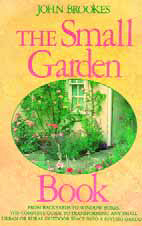Small Wonders

On several occasions through the past few years, I’ve been called on to design several projects that were both extremely small and extremely detailed. I’ve found that working in these intimate spaces is a tremendous challenge, with every single detail taking on tremendous importance and even something as innocuous as the mortar color making or breaking an entire scene.
At the same time, I’ve found these projects to be exceptionally rewarding because of the intensity of the effects and the subtlety of the ambiances I’ve managed to create: Those same details are so immediate and close at hand that I would even argue that their emotional impact is heightened to levels not possible in more expansive designs.
Looking to add to my own well of inspiration with these projects, I set out to find resources to help me deal with designs in miniature. I came up big, with three terrific books that look at the process from different angles.
 Small Garden by John Brookes (Dorling Kindersley, 1989). Although it is 20 years old, this book is timeless. Brookes (whom I idolize) is a master gardener, and the book puts a number of his early works in England on display. Along the way, he addresses the subject of working in small spaces by looking at elements in the garden, from plants and hardscape to water and much more.
Small Garden by John Brookes (Dorling Kindersley, 1989). Although it is 20 years old, this book is timeless. Brookes (whom I idolize) is a master gardener, and the book puts a number of his early works in England on display. Along the way, he addresses the subject of working in small spaces by looking at elements in the garden, from plants and hardscape to water and much more.
His description of his extremely methodical design process offers tremendous insights on ways to make keen stylistic statements, and the illustrations that fill the book’s 220 pages include both photographs and his hand renderings – all revealing the remarkable creative range of one of today’s greatest designers.
 Small Spaces, Beautiful Gardens by Keith Davitt (Rockport Publishers, 2001). This appropriately slim volume takes on small spaces through case studies generated by a well-known designer (and past WaterShapes contributor) who has specialized in private and public gardens in and around New York City for many years.
Small Spaces, Beautiful Gardens by Keith Davitt (Rockport Publishers, 2001). This appropriately slim volume takes on small spaces through case studies generated by a well-known designer (and past WaterShapes contributor) who has specialized in private and public gardens in and around New York City for many years.
His is an urban practice that obviously involves work in tight confines, and he uses his case studies to explore issues of organization, proportion and a range of design fundamentals with a special focus on thinking small. It’s just 140 pages long, but Davitt’s compact text offers wonderful insights into the thought processes that shape his designs.
 The Small Garden Planner by Graham Rose (Mitchell Beazley, 1987). This book, by an esteemed, London-based garden writer, covers small spaces from the perspectives of a number of designers using a variety of styles and approaches, again in a case-study format.
The Small Garden Planner by Graham Rose (Mitchell Beazley, 1987). This book, by an esteemed, London-based garden writer, covers small spaces from the perspectives of a number of designers using a variety of styles and approaches, again in a case-study format.
The book’s 170 pages are beautifully illustrated and well-formatted, with each entry including plan views of the project that helped me understand how these spaces are organized and how small spaces can be set up in ways that bring variety and even surprise to intimate settings.
It bears mentioning that none of the projects covered in these books includes a swimming pool or spa, although a number do include small ponds and fountains. Nonetheless, as a pool designer I value them all for the information they offer about design methodology and a sense of discipline that applies to jobs both small and large.
Mike Farley is a landscape architect with more than 20 years’ experience and is currently a designer/project manager for Claffey Pools in Southlake,Texas. After receiving his degree in landscape architecture from Texas Tech University, he began his professional career in California with a high-end landscape-design firm through which he became involved in several pool-remodeling projects. He later joined Geremia Pools in Sacramento, Calif., where he worked for six years before returning to Texas in 1998. A graduate of the Genesis 3 schools, he assumed his current position in the fall of 2003.










